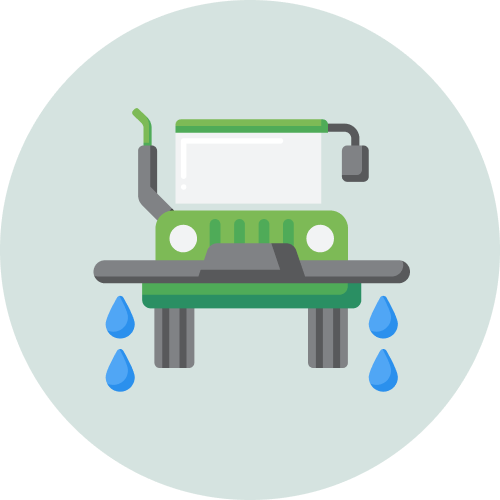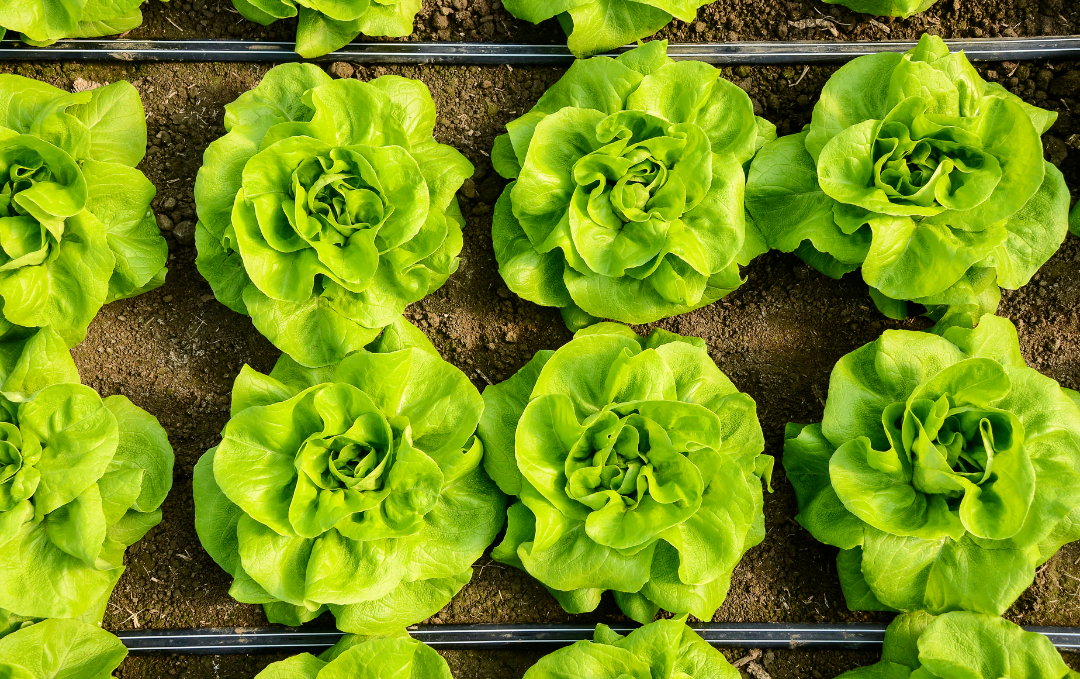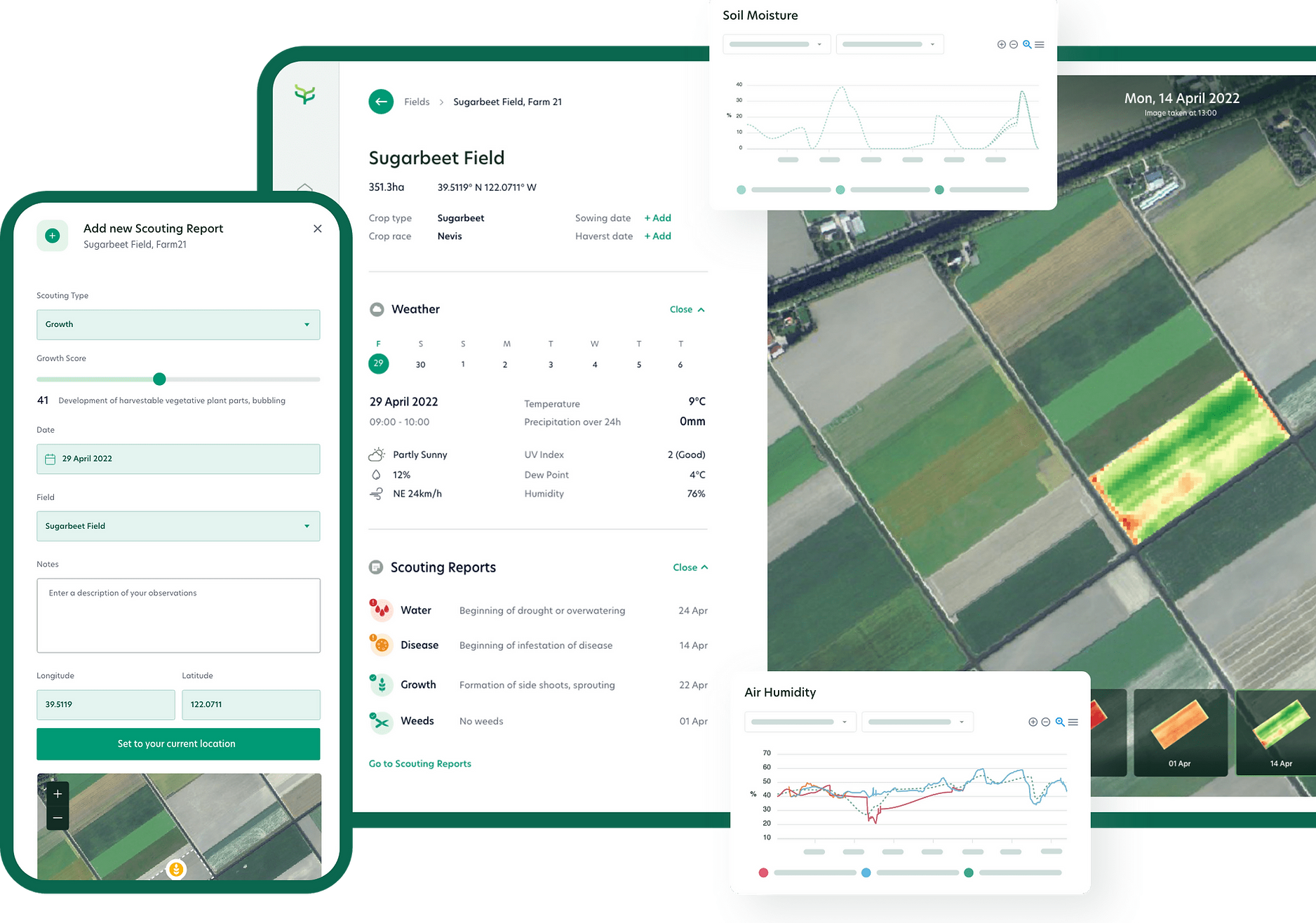Farming Smarter With Soil Moisture Monitoring Devices.
In this article we’ll discuss why soil moisture content is a critical metric, the different types of soil moisture monitoring devices, which factors to consider when selecting a device and we’ll take a closer look Farm21’s comprehensive solution.
The power of precision.
Precision agriculture is becoming an increasingly important topic in the agricultural industry, as growers are under pressure to optimise crop production while minimising their environmental impact.
One key aspect of precision agriculture is the use of soil moisture monitoring devices. These tools provide farmers, agricultural researchers, and crop advisors with valuable insights for data-driven decision making.
Precision Farming’s Most Important Metric
Soil moisture content is one of precision farming’s most important metrics because it directly affects crop growth, yield, and quality. Let’s first take one step back to unpack the concept of precision farming. Precision farming enables you to apply the right resources, at the right time and in the right quantities to ensure optimal production and minimum wastage of resources. In other words, precision farming refers to using data-driven approaches to make informed decisions and optimise farm management practices. Soil moisture content is a crucial factor in many of these decisions as it affects the availability of water and nutrients to plants.
Soil moisture content can also vary widely across a field due to soil type, topography, and weather conditions. Precision farming techniques, including the use of soil moisture monitoring devices, can help identify these variations and adjust management practices accordingly. This allows growers to target specific areas of their fields with appropriate amounts of water and fertiliser, reducing waste and maximising efficiency.
Adding to that, by accurately measuring soil moisture content, it is possible for growers to determine the optimal timing and amount of irrigation and fertilisation needed to promote healthy plant growth. Overwatering or under-watering can lead to reduced crop yields, wasted resources, and environmental damage. With precise knowledge of soil moisture levels, farmers can avoid these pitfalls and achieve maximum productivity while farming more sustainably.
To summarise, soil moisture content is a critical metric in precision farming because it directly affects crop health and productivity. By measuring and managing soil moisture content with precision farming tools and techniques, growers can optimise their practices for maximum efficiency, sustainability, and profitability. This is an important step for achieving balanced farming (where food is produced with a perfect balance and preservation of social, environmental, and financial factors).
Types of Soil Moisture Monitoring Devices
There are several types these devices, each with its own advantages and disadvantages. Let’s take a look at the different types below:
- Tensiometers: Tensiometers are one of the most common types of soil moisture monitoring devices. They consist of a tube with a porous tip that is inserted into the soil. The tube is filled with water, and a vacuum is applied to the top of the tube. As the soil around the tip dries out, the tension in the tube increases, indicating a decrease in soil moisture content. Tensiometers are relatively inexpensive and provide continuous readings, but they require regular maintenance and can be affected by soil compaction and temperature fluctuations.
- Time Domain Reflectometry (TDR) Sensors: TDR sensors use electromagnetic waves to measure soil moisture content. They consist of a probe that is inserted into the soil, and the probe sends out an electromagnetic pulse. The moisture content of the soil affects the speed at which the pulse travels through the soil. TDR sensors provide precise and accurate readings, and they can be used in a wide range of soil types. However, they are relatively expensive and require skilled operators to install and maintain.
- Capacitance Sensors: Capacitance sensors measure soil moisture content by measuring changes in electrical conductivity. They consist of a probe that is inserted into the soil, and the probe sends out an electrical signal that is affected by the moisture content of the soil. Capacitance sensors are relatively inexpensive and easy to install, and they provide continuous readings. However, they can be affected by soil salinity and temperature fluctuations, which can lead to inaccurate readings.
- Neutron Probes: Neutron probes measure soil moisture content by measuring the amount of hydrogen in the soil. They consist of a probe that is inserted into the soil, and the probe emits neutrons that interact with the hydrogen atoms in the soil. The amount of hydrogen detected is proportional to the amount of moisture in the soil. Neutron probes provide accurate readings and can be used in a wide range of soil types, but they are relatively expensive and require specialised training to operate.
Critical Factors To Consider Before Selecting a Soil Moisture Sensor
When choosing a soil moisture monitoring device, several factors must be considered to ensure the device meets the users specific needs. The following are some key factors to consider:
- Accuracy and Precision: The accuracy and precision of the soil moisture monitoring device is probably the most important factor. Without accurate measurements, it is impossible to make fact-based decisions. The device must, of course, provide accurate and precise readings to ensure that irrigation and fertilisation practices are optimised. The accuracy and precision of the device can be affected by soil type, temperature, and other factors, so it’s crucial to select a device that is appropriate for the specific soil type and conditions.
- Ease of Installation: The ease of installation is another essential factor to consider when choosing a soil moisture monitoring device. Some devices may require specialised training or tools to install, while others can be easily installed without any specialised tools, skills or knowledge. A device that is easy to install saves time, labour and costs and ensures users can get insights without effort.
- Cost: The cost of the soil moisture monitoring device is also a critical consideration. It will determine the quantity that can deployed and the more sensors throughout the field, the higher the data-density. Some devices may be relatively inexpensive, while others may be quite expensive. It’s essential to consider the cost of the device in relation to its accuracy and precision, ease of installation, and maintenance requirements.
- Maintenance requirements: The maintenance requirements of the device are also essential to consider. Some devices may require regular calibration or cleaning, while others may require little to no maintenance. It’s important to select a device that has maintenance requirements that are compatible with the user’s resources and schedule.
- Compatibility with existing technology: The compatibility of the soil moisture monitoring device with existing technology is another factor to consider. If the user already has irrigation or fertilisation systems in place, it’s vital to choose a device that is compatible with these systems. The device should be able to integrate with existing technology to provide a seamless and efficient system.
Overall, choosing the right soil moisture monitoring device is critical for effective farm management. By considering factors such as accuracy and precision, ease of installation, cost, maintenance requirements, and compatibility with existing technology, farmers can select the best device for their specific needs and achieve maximum productivity and ROI.
Expected Benefits of Using Soil Moisture Probes
Soil moisture monitoring devices offer many benefits. Below are some of the advantages of using soil moisture monitoring devices (specifically for farmers and crop advisors) and examples of how they can be utilised in agriculture:
- Increased Crop Yields: Soil moisture monitoring devices can help farmers optimise irrigation practices and ensure that crops receive the appropriate amount of water. This, in turn, directly affects crop yields. For example, a farmer using a soil moisture sensor can accurately determine the soil moisture content and adjust irrigation systems to ensure that crops receive the right amount of water. This can lead to increased crop yields and improved plant health. This apple case study illustrates how a farmer in the Netherlands obtained accurate, reliable data to make the best fertilisation and irrigation decisions.
- Water Conservation: Water conservation is an essential consideration in agriculture. Soil moisture monitoring devices can help farmers optimise irrigation practices and reduce water waste. For instance, by using a soil moisture sensor, farmers can avoid overwatering crops, reducing water waste and conserving this precious resource.
- Soil Protection: Efficient water management is critical for soil protection because it helps ensure that crops receive the appropriate amount of water they need to grow, without excess water causing soil erosion or leaching of nutrients. Soil moisture monitoring devices can accurately measure the amount of water in the soil and provide real-time data that can be used to optimise irrigation practices, reduce water waste, and minimise the potential for soil erosion.
There are a multitude of benefits that result from optimum water management. This is why in-field soil moisture monitoring devices are an increasingly important tool on farms as it provides valuable insights to support efficient water management:
The Value for Agricultural Researchers
Agricultural research encompasses a wide range of scientific studies aimed at improving the productivity, efficiency, and sustainability of agricultural systems. This includes research on crop genetics, plant breeding, soil science, pest management, and agricultural engineering, among other fields. For example, soil moisture sensors can provide several benefits for biostimulant research, including:
- Improved understanding of biostimulant effectiveness: Soil moisture sensors can provide real-time data on soil moisture levels, which can be used to determine the effectiveness of biostimulant treatments. By monitoring soil moisture levels before and after biostimulant application, researchers can better understand how these products impact plant water use and nutrient uptake.
- Optimisation of biostimulant application rates: Soil moisture sensors can be used to optimise the timing and application rates of biostimulant products. By measuring soil moisture levels, researchers can determine the optimal time to apply biostimulants and ensure that the products are applied at the appropriate rate to maximise their effectiveness.
- Identification of soil moisture stress: Soil moisture sensors can be used to identify areas of the field that are experiencing water stress, which can be used to target biostimulant treatments to these areas. By using biostimulants to help alleviate water stress, researchers can improve plant health and productivity.
- Improved understanding of soil health: Soil moisture sensors can provide data on soil moisture levels over time, which can be used to assess soil health and identify areas that may be in need of soil amendments or other treatments. By using biostimulants to improve soil health, researchers can help promote optimal plant growth and productivity.
An interesting example is from The Seaweed Company, where soil moisture sensors were used in researching and developing their product, TopHealth Plants. It’s a liquid, easy-to-spray seaweed blend that boosts plant growth, strength, and immune system. Seaweed extracts are rich in alginates and alginic acid. These substances are super absorbent and act like micro-jellies, holding the water in the soil longer. This promotes robust root growth in the early phases of plant development, allowing the roots to hold and absorb more nutrients and water, establishing a virtuous cycle for plant and soil health. The Seaweed Company used Farm21’s soil moisture sensors to monitor the soil moisture percentage difference between control and THP-treated strokes.
Farm21’s Solution
Farm21’s soil moisture sensor and data platform solution is designed to provide growers, researchers and crop advisors with accurate and reliable insights to help optimise resource usage and improve crop productivity.
The proprietary soil moisture sensors FS21 is one of the most affordable sensors on the market and, in addition to that, super simple to install. The sensor measures the 7 most critical values including soil moisture (at -30cm, -20cm and -10cm), soil temperature (at -20cm and -10cm) as well as air temperature and humidity below the crop canopy.
The smart farming data platform is designed to be user-friendly and easy to use. It pulls real-time information from multiple sources (including weather applications, satellite data and scouting reports) for a complete overview of what is happening in the field. Users also have access historical data and analytics to help identify trends and patterns over time.
The sensors are plug and play, can be moved without effort and requires minimal maintenance. Their affordability means they can be deployed at scale for ultimate data-density.


Take Action
Treat, spray & irrigate crops with sensors in place
Long Lasting
Recharge battery with USB-C and lasting a full year on a single charge
Measure
Measures right under the crop canopy for actual crop climate
Connectivity
Narrowband-IoT,
LTE-M & 2G connectivity for easy deployment
Affordable
5 to 10 times more affordable than any competing device
API Integration
Instead of using our platform, integrate your own through the API
Easy Installation
Factory calibrated, done in 30 seconds
Modular Design
Our sensors support
other modules or third-party sensors
Farm21 is committed to the sustainable development and implementation of agriculture technology tools and techniques that ensures a healthy future – for people and the planet.

Find a time to meet with one of our partnership managers to find out more about Farm21’s offering:
Create a FREE account and start scouting today
One easy-to-use platform for all your scouting reports, the perfect place to log and share insights with external stakeholders
Download our app

